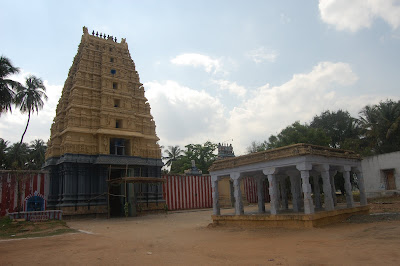RAMESWARAM
Rameswaram, a small island in the Gulf of Mannar, is a major pilgrim centre. It is connected Mandapam on the mainland by road and rail bridges. Every devout Hindu hopes to pray at Rameswaram at least once in his lifetime. Rameswaram is holy because Sri Rama offered his thanks to Lord Siva here, as soon as he set foot on Indian soil on his return from Sri Lanka. The place is thus equally sacred to both Vaishnavites and Saivites.
Legend has it that on reaching Rameswaram, Sri Rama sent Hanuman to Mount Kailas to bring a Lingam for worship. The auspicious time for the Puja drew near and Hanuman had not returned. So, Sita molded a Lingam from sand (The Ramanatha), and prayers were offered at the right time. When Hanuman returned late with the Lingam from Kailas, he was distressed. Sri Rama in a typically generous gesture, in all rituals and worship.
 The Ramanatha Swamy Temple which is closed to the sea on the eastern side of the island is renowned for magnificent corridors with massive sculptured pillars lining it. The corridor is the longest in India. It is 197 meters long (East-West), 133 meters in length (South-North). The temple has a tower (Gopuram) 38.4 meters high. The temple as it stands today was built by different rulers at different periods from the 12th century A.D. onwards.
The Ramanatha Swamy Temple which is closed to the sea on the eastern side of the island is renowned for magnificent corridors with massive sculptured pillars lining it. The corridor is the longest in India. It is 197 meters long (East-West), 133 meters in length (South-North). The temple has a tower (Gopuram) 38.4 meters high. The temple as it stands today was built by different rulers at different periods from the 12th century A.D. onwards.AGNITHEERTHAM:
The Ramanath Swamy Temple faces east. The sea here, about 100 meters from the main entrance to the temple, is very calm. The water at this place is considered sacred and is known as “Agnitheertham”, where people bathe.
THE GANDAMADANA PARVATHAM (hillock):
It is situated to the north of the temple on the highest point in the island. It is a two-storied Mandapam where the imprint of Lord Rama’s feet (Padam) are placed on a chakra. It is 3 Kms from the main Temple.
DHANUSHKODI
The southernmost tip of the island Dhanushkodi was completely washed away by the 1964 Cyclone. But the Kothandaramaswamy Temple north of here remains intact, and can be reached by road from Rameswaram. Icons of Sri Rama, Sita, Lakshmana, Hanuman and Vibishna are here. This place is 18 Kms from Rameswaram.
KURUSADI ISLAND:
About 23 kms from Rameswaram via Mandapam, (5 kms from Mandapam), the island lies to the west of the Pamban Bridge. It is a paradise for biologists. There are a number of other islands in the area.
RAMANATHAPURAM:
 It is the headquarters of the district. This is an ancient town from where the Sethupath’s ruled their territory. The Ramalinga Vilasam Palace with good paintings is worth visiting. The tomb of Thayumana Swamigal, a philosopher saint, is located here.
It is the headquarters of the district. This is an ancient town from where the Sethupath’s ruled their territory. The Ramalinga Vilasam Palace with good paintings is worth visiting. The tomb of Thayumana Swamigal, a philosopher saint, is located here.THIRUPULANI:
Also known as Dharbasayanam. It is 14 kms from Ramanathapuram. There is a Vishnu temple here dedicated to Lord Adi Jagannathaperumal. Sri Rama is said to have worshipped the deity here and secured a bow to fight Ravana. It is also said that Rama lay on Dharba grass bed for seven days in order to pray for a safe passage to Sri Lanka. About 4 kms from here, the famous pilgrim center Sethukarai.
DEVIPATTINAM:
Also known as Navabashanam. It is a costal village 15 kms from Ramanathapuram where perform their penance. Nine stones installed by Rama in the sea here represent nine planets. There is also a temple dedicated to Devi who is said to have killed the demon Mahishasura at this spot.
UTHIRAKOSAMANGAI:
 It is 18 Kms from Ramanathapuram and 32 Kms from Paramakudi. There is an ancient Siva temple dedicated to Lord Nataraja. A deity here is carved in EMERALD. The annual “festival in December attracts a large number of devotees.
It is 18 Kms from Ramanathapuram and 32 Kms from Paramakudi. There is an ancient Siva temple dedicated to Lord Nataraja. A deity here is carved in EMERALD. The annual “festival in December attracts a large number of devotees.ERWADI:
It is 8 Kms from Keezhakarai and 24 kms from Ramanathapuram. The tomb of Ibrahim Syed Aulia is visited by the Muslim pilgrims from India, Sri Lanka, Malaysia and Singapore. The annual festival in honor of this Muslim saint, takes place in December.
UPPOOR:
There is a Vinayagar temple at this place. It is 30 kms from Ramanathapuram. It is said that Sri Rama worshiped the Vinayagar here on his way to Sri Lanka.
VALINOKKAM :
It is 90 Kms from Rameswaram. A seaside with a verdant beach and natural scenery. The sea here is very calm.







































